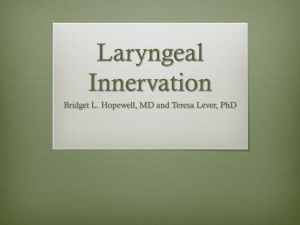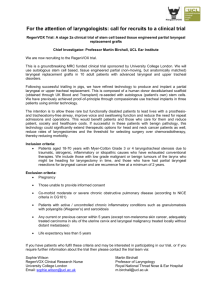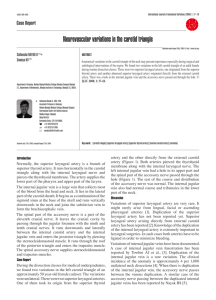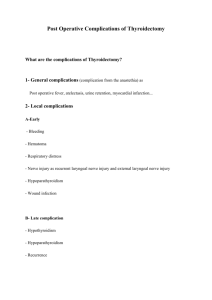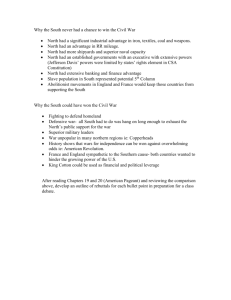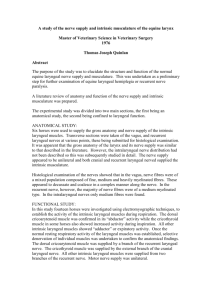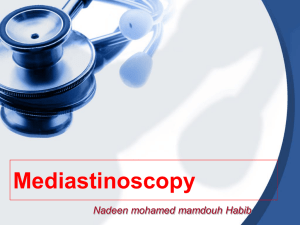Surgical anatomy of the internal branch of the superior laryngeal nerve
advertisement
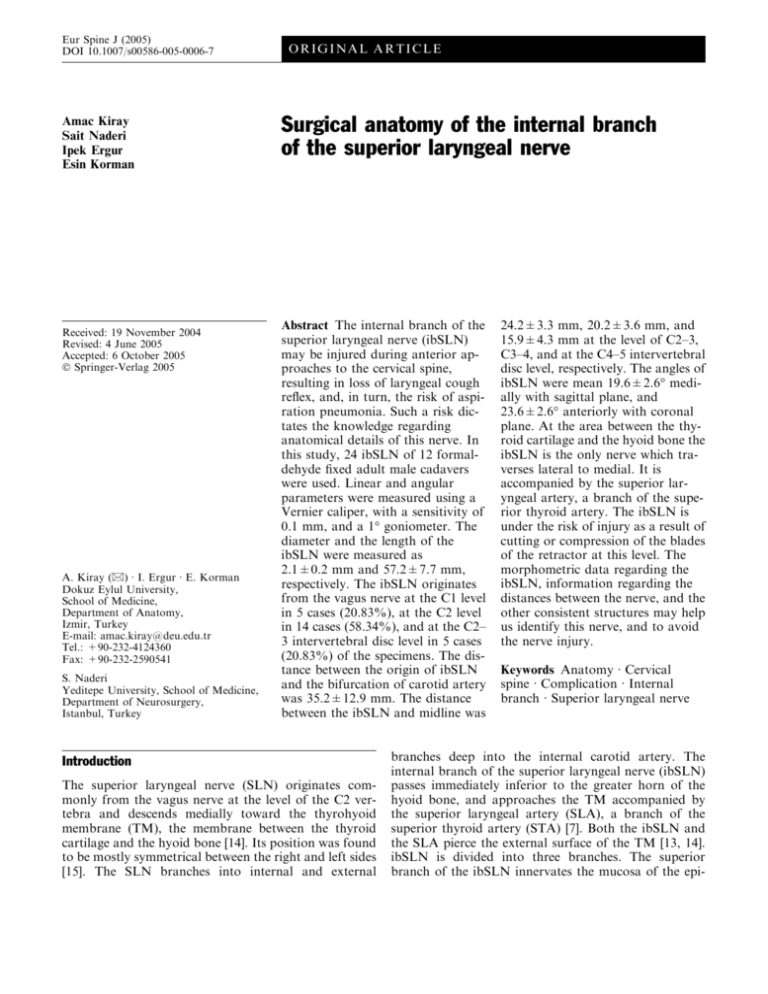
Eur Spine J (2005) DOI 10.1007/s00586-005-0006-7 Amac Kiray Sait Naderi Ipek Ergur Esin Korman Received: 19 November 2004 Revised: 4 June 2005 Accepted: 6 October 2005 Ó Springer-Verlag 2005 A. Kiray (&) Æ I. Ergur Æ E. Korman Dokuz Eylul University, School of Medicine, Department of Anatomy, Izmir, Turkey E-mail: amac.kiray@deu.edu.tr Tel.: +90-232-4124360 Fax: +90-232-2590541 S. Naderi Yeditepe University, School of Medicine, Department of Neurosurgery, Istanbul, Turkey ORIGINAL ARTICLE Surgical anatomy of the internal branch of the superior laryngeal nerve Abstract The internal branch of the superior laryngeal nerve (ibSLN) may be injured during anterior approaches to the cervical spine, resulting in loss of laryngeal cough reflex, and, in turn, the risk of aspiration pneumonia. Such a risk dictates the knowledge regarding anatomical details of this nerve. In this study, 24 ibSLN of 12 formaldehyde fixed adult male cadavers were used. Linear and angular parameters were measured using a Vernier caliper, with a sensitivity of 0.1 mm, and a 1° goniometer. The diameter and the length of the ibSLN were measured as 2.1±0.2 mm and 57.2±7.7 mm, respectively. The ibSLN originates from the vagus nerve at the C1 level in 5 cases (20.83%), at the C2 level in 14 cases (58.34%), and at the C2– 3 intervertebral disc level in 5 cases (20.83%) of the specimens. The distance between the origin of ibSLN and the bifurcation of carotid artery was 35.2±12.9 mm. The distance between the ibSLN and midline was Introduction The superior laryngeal nerve (SLN) originates commonly from the vagus nerve at the level of the C2 vertebra and descends medially toward the thyrohyoid membrane (TM), the membrane between the thyroid cartilage and the hyoid bone [14]. Its position was found to be mostly symmetrical between the right and left sides [15]. The SLN branches into internal and external 24.2±3.3 mm, 20.2±3.6 mm, and 15.9±4.3 mm at the level of C2–3, C3–4, and at the C4–5 intervertebral disc level, respectively. The angles of ibSLN were mean 19.6±2.6° medially with sagittal plane, and 23.6±2.6° anteriorly with coronal plane. At the area between the thyroid cartilage and the hyoid bone the ibSLN is the only nerve which traverses lateral to medial. It is accompanied by the superior laryngeal artery, a branch of the superior thyroid artery. The ibSLN is under the risk of injury as a result of cutting or compression of the blades of the retractor at this level. The morphometric data regarding the ibSLN, information regarding the distances between the nerve, and the other consistent structures may help us identify this nerve, and to avoid the nerve injury. Keywords Anatomy Æ Cervical spine Æ Complication Æ Internal branch Æ Superior laryngeal nerve branches deep into the internal carotid artery. The internal branch of the superior laryngeal nerve (ibSLN) passes immediately inferior to the greater horn of the hyoid bone, and approaches the TM accompanied by the superior laryngeal artery (SLA), a branch of the superior thyroid artery (STA) [7]. Both the ibSLN and the SLA pierce the external surface of the TM [13, 14]. ibSLN is divided into three branches. The superior branch of the ibSLN innervates the mucosa of the epi- glottis and a small part of the anterior wall of the vallecula. The middle branch is a sensory branch, which innervates the aryepiglottic folds. The inferior branch sends a few twigs to the interarytenoid muscles [13, 14, 16, 17]. The ibSLN is sensitive to the laryngeal mucosa down to the level of the vocal folds. It also carries afferent fibers from the laryngeal neuromuscular spindles and other stretch receptors. The SLN may be injured during the anterior or anterolateral cervical spine surgery, thyroid surgery and during carotid endarterectomy [1–3, 6, 10]. Routinely the main trunk and posterior descending branch of the ibSLN was preserved in supraglottic laryngectomy by identification of the main trunk in the viscero-vertebral angle medial to the carotid bifurcation [5]. The rate of SLN palsy varies from 9 to 14% in thyroid surgery [10], from 1 to 4.5% in carotid endarterectomy operations [8], and 8% in anterior cervical fusion operations [4]. Injury to the ibSLN results in impairment of the laryngeal cough reflex [12,18]. This reflex protects humans against foreign material aspiration that potentially could result in aspiration pneumonia and other respiratory illnesses [17]. However, the dual innervation of the larynx by SLN decreases the risk of manifest cough reflex loss. Such a risk necessitates a clear definition of the morphometric and regional anatomy of the ibSLN. This study aims to define the location and trajectory of this nerve, and its vulnerability during anterior cervical spine procedures. Materials and methods Twelve adult male cadaver specimens were used for this study. An anterior approach to the cervical spine was performed to dissect the SLN, the ibSLN and its branches. The ibSLN of both sides of the 12 cadavers (24 ibSLN) were dissected under a Carl Zeiss steroscopic dissection microscope. The vagus nerve was carefully dissected from the jugular foramen to the origin of the trunk of the SLN. Subsequently, the internal and external branches of the SLN were dissected upto their entrance into the larynx. Linear and angular parameters were measured using a Vernier caliper, with a sensitivity of 0.1 mm, and a 1° goniometer. Statistical analysis was performed using Mann Whitney U tests. P<0.05 was considered significant. The measured parameters are listed in Table 1. Results The SLN arises from the vagus nerve within the carotid sheath at the level of C1–C2 and crosses the internal carotid artery. The SLN bifurcates into internal and external laryngeal branches which are located beneath the internal carotid artery (Fig. 1). The distance between the origin and bifurcation of the SLN was measured to be 14.1±4.2 mm (mean ± SD). The ibSLN arises from the SLN at the level of C1 in 5 cases (20.83%), at the level of C2 in 14 cases (58.34%), and at the level of the C2–3 intervertebral disc in 5 cases (20.83%). The ibSLN was measured to be localized ventral to the superior cervical ganglion in 16 cases (66.67%), and was medial to it in 8 cases (33.33%). The SLN descends in a vertical direction, with an angle of 19.6±2.6° (mean ± SD) from the superolateral to the inferomedial, relative to the sagittal plane, and with an angle of 23.6±2.6° from the posterosuperior to the anteroinferior, relative to the coronal plane (Fig. 2). The distance between the ibSLN and midline was measured as 24.2±3.3 mm, 20.7±3.6 mm, and 15.9± 4.3 mm at the level of C2–3, C3–4, and at the C4–5 intervertebral disc, respectively. The distances between the ibSLN and the anterior surface of the C2–3, C3–4, and C4–5 intervertebral discs were measured as 9.6±3.2 mm, 15.2±4.6 mm, and 23.0±5.2 mm, respectively. The measurements of the right and left sides are listed in Table 2. The distance between the origin of the ibSLN and bifurcation of the common carotid artery was 35.2±12.9 mm. The distance between the common carotid artery and the point at which the ibSLN pierces the TM was 7.0±6.3 mm. The distance between laryngeal prominence and the point at which the ibSLN pierces the TM was 13.7±2.8 mm. The mean diameter of the ibSLN was 2.1±0.2 mm at the level of the C3 vertebra. It was found that the ibSLN was branched more deeply to the piercing point of the TM in 15 cases (62.5%) (Fig. 3) and was branched out proximally to the piercing point of the TM in 9 cases (37.5%, Fig. 4). According to their destination, the branches of the ibSLN could be grouped into superior, middle, and inferior branches. The mean diameters of the superior, middle, and inferior branches of the ibSLN at the point where they pierce the TM were found to be 1.2±0.2 mm, 1.5±0.2 mm, and 1.2±0.3 mm, respectively. The ibSLN crossed the SLA approximately 31.4 mm superior to the upper pole of the thyroid gland in 18 cases (75%, Fig. 3) and did not in 6 cases (25%, Fig. 4). The ibSLN crossed with the STA approximately 33.0 mm at the upper pole of the thyroid gland in 9 cases (37.5%), and did not in 15 cases (62.5%). The distance between the origin of the ibSLN and the termination of the middle ramus was 57.2±7.7 mm. The mean distance between the greater cornu of the hyoid bone and the point of termination of the middle branch of the ibSLN was 25.8±5.5 mm. Table 1 The measured parameters Lengths Distances Relations Diameters Angle Vertebra levels The length of the SLN The length of the ibSLN Distance between the ibSLN and the anterior surface of the corresponding intervertebral discs Distance between the greater horn and the point at which the middle branch of the ibSLN pierces the TM Distance between the ibSLN and midline at the level of the intervertebral disc Relations between the ibSLN and superior cervical ganglion Relation between the ibSLN and SLA Relation between the ibSLN and STA Relation between the branches of ibSLN and TM Diameter of the ibSLN Diameters of the superior, middle, and inferior branches of the ibSLN Angles of ibSLN with respect to the sagittal and coronal planes The level at which the middle branch of the ibSLN pierces the TM The branching point of the ibSLN from the SLN SLN, Superior laryngeal nerve; ibSLN, Internal branch of the superior laryngeal nerve; SLA, Superior laryngeal artery; STA, Superior thyroid artery; TM, thyrohyoid membrane The medial branch of the ibSLN pierces the TM at the level of the C4 vertebra in 12 cases (50%), at the level of the C4–5 intervertebral disc in 6 cases (25%), and at the level of the C5 vertebra in 6 cases (25%). Discussion Fig. 1 Relations between the ibSLN and SLN and the other anatomic structures. ibSLN internal branch of the superior laryngeal nerve, ECA external carotid artery, SLA superior laryngeal artery The fact that ibSLN injury causes cough reflex loss requires knowledge regarding the morphology of this nerve. The most important area in which this nerve is under the risk of injury is around the TM, i.e., between the thyroid cartilage and hyoid bone. In this area, the ibSLN is the only nerve traversing lateral to medial, and in most cases is accompanied with the SLA, a branch of the STA [13, 14, 16–18]. The SLN originates from the vagus nerve at the level of the C1 and C2 vertebra, and in most cases bifurcates into the internal and external branches beneath the internal carotid artery at the level of the C2 vertebra [14]. The distance between the origin of the SLN and the bifurcation point was reported to be 15 mm (3–20 mm) by Melamed [12], 21 mm by Lang et al. [11], 16.7± 0.9 mm by Furlan et al. [9] and 14.1±4.2 mm in our present work. The SLN descends in a vertical direction, with an angle of 19.6±2.6° from superolateral to inferomedial, relative to the sagittal plane, and with an angle of 23.6±2.6° from posterosuperior to anteroinferior, relative to the coronal plane. The ibSLN is located ventral to the superior cervical ganglion in 66.67% of the cases, and is located medial to it in 33.33% of cases. The length of the ibSLN was reported to be 64 mm by Lang [11], 44.9±1.0 mm by Furlan [9], and was found to be 57.2±7.7 mm in our study. The total length of the SLN and ibSLN was measured to be 71 mm in our studies. The SLN and its branches may be stretched along their relatively long course by medial and rostral Fig. 2 The angles of ibSLN with respect to SP and CP. ibSLN internal branch of the superior laryngeal nerve, SP sagittal plane, CP coronal plane blades of retractors during retraction for cervical spine exposure. The diameter of the ibSLN was found to be 1.8– 2.0 mm by Stephens et al. [17], and 2.1±0.2 mm in the present study. This relatively thin nerve may be ligated or cut during surgical approaches. As mentioned before, the external and internal branches of SLN are the only nerves traversing lateral to medial at this level. Although the hypoglossal nerve has a similar direction, this nerve is more superficial and superior than the branches of the SLN, and unlike these nerves directs upward. A close relation between ibSLN and other structures during Table 2 Measurements of the right and left sides exposure along its long course should be taken into consideration. The ibSLN crosses the greater cornu of the hyoid bone, prior to piercing the TM. The distance between the TM piercing point and the point at which the ibSLN crosses the greater cornu was reported to be 28.52±4.61 mm by Stephens et al. [17]. The same distance was measured as 25.8±5.5 mm here. According to Melamed et al. [12], the ibSLN pierces the TM at the level of the C3–4 intervertebral disc. Our studies, however, revealed that the ibSLN pierces the TM at the level of C4 in 12 cases (50%), at the level of SLN–ibSLN Lengths The length of the SLN The length of the ibSLN Distances ibSLN–anterior surface of the C2–3 IVD ibSLN–anterior surface of the C3–4 IVD ibSLN–anterior surface of the C4–5 IVD greaer horn –middle branch pierces the TM ibSLN –idline at the C2– IVD ibSLN –idline at the C3– IVD ibSLN –idline at the C4– IVD Diameters IbSLN Superior banch of ibSLN Middle banch of ibSLN Inferior banch of ibSLN Angles ibSLN–agittal plane ibSLN–oronal plane Right Left Mean 14.8±4.4 58.0±8.2 13.5±4.0 56.3±7.4 14.1±4.2 57.2±7.7 10.7±3.5 16.3±5.7 22.3±5.6 25.9±6.2 24.0±3.6 20.1±3.6 15.5±5.0 8.0±2.0 14.0±3.0 23.5±5.3 25.6±5.0 24.5±3.1 21.3±3.6 16.3±4.2 9.6±3.2 15.2±4.6 23.0±5.2 25.8±5.5 24.2±3.3 20.7±3.6 15.9±4.3 2.2±0.1 1.2±0.2 1.6±0.3 1.2±0.2 2.0±0.3 1.3±0.2 1.5±0.2 1.2±0.3 2.1±0.2 1.2±0.2 1.5±0.2 1.2±0.3 18.9±2.1 23.0±4.1 20.3±2.9 24.3±5.2 19.6±2.6 23.6±4.6 Fig. 3 A case of the ibSLN branching out deep to the TM and ibSLN crossing the SLA. ibSLN internal branch of the superior laryngeal nerve, SLA superior laryngeal artery, TM thyrohyoid membrane, BC bifurcatio carotidea Fig. 4 A case of the ibSLN uncrossing the SLA and ibSLN branching out proximally to the TM. ibSLN internal branch of the superior laryngeal nerve; ECA external carotid artery: a superior branch, b middle branch, c inferior branch; SLA superior laryngeal artery; TM thyrohyoid membrane the C4–5 intervertebral disc in 6 cases (25%), and at the level of C5 vertebra in 6 cases (25%). This localization should be taken into consideration during the placement of blades of retractors, both cranially and medially. The ibSLN is divided into three branches either before or after piercing the TM. Stephens et al. [17] reported that the ibSLN branched distal to the TM in 21 of 25 cases, and proximal to it in four cases. This is in part parallel to the results of our study, in which the ibSLN branched distal to the TM in 15 cases (62.5%), and proximal to it in 9 cases (37.5%). Stephens et al. [17] measured the distance between the TM and ibSLN trifurcation as 6.95±3.71 mm. The same distance was measured as 11.7±3.8 mm in our study. Conclusion In summary, anterior and anterolateral approaches to the upper cervical spine may result in ibSLN injury. This requires knowledge regarding the course of this nerve. This study revealed that the ibSLN descends anteromedially, and reaches the TM. The described course of this nerve may lead to an injury due to a stretch by retraction, ligation or cutting, particularly in the middle area of the cervical spine. References 1. AbuRahma AF, Choueiri MA (2000) Cranial and cervical nerve injuries after repeat carotid endarterectomy. J Vasc Surg 32(4):649–654 2. Aldori MI, Baird RN (1988) Local neurological complication during carotid endarterectomy. J Cardiovasc Surg 29:432–436 3. Ballotta E, Da Giau G, Renon L, Narne S, Saladini M, Abbruzzese E, Meneghetti G (1999) Cranial and cervical nerve injuries after carotid endarterectomy: a prospective study. Surgery 125(1):85–91 4. Burger RF, Rejowski JE, Beatty RA (1985) Vocal cord paralysis associated with anterior cervical fusion: consideration for prevention and treatment. J Neurosurg 62:657–666 5. El-Guindy A, Abdel Aziz M (2000) Superior laryngeal nerve preservation in peri-apical surgery by mobilization of the viscerovertebral angle. J Laryngol Otol 114(4):268–273 6. Evans WE, Mendelowitz DS, Liapis C, Wolfe V, Florence CL (1982) Motor speech deficit following carotid endarterctomy. Ann Surg 196(4):461–464 _ 7. Friedman M, Lo Savio Phillip, Ibrahim Hani (1985) Superior laryngeal nerve identification and preservation in thyroidectomy. Arch Otolaryngol Head Neck Surg 128:296–303 8. Furlan JC, de Magalhaes RP, de Aguiar ET, Shiroma S (2002) Localization of the superior laryngeal nerve during carotid endarterectomy. Surg Radiol Anat 24(3–4):190–193 9. Furlan JC, Brandao LG, Ferraz AR, Rodrigues AJ Jr (2003) Surgical anatomy of the extralaryngeal aspect of the superior laryngeal nerve. Arch Otolaryngol Head Neck Surg 129(1):79–82 10. Hillermann CL, Tarpey J, Phillips DE (2003) Laryngeal nerve identification during thyroid surgery—feasibility of a novel approach. Can J Anaesth 50(2):189–192 11. Lang J, Nachbaur S, Fischer K, Vogel E (1987) The superior laryngeal nerve and the superior laryngeal artery. Acta Anat (Basel) 130(4):309–318 12. Melamed H, Harris MB, Awasthi D (2002) Anatomic considerations of superior laryngeal nerve during anterior cervical spine procedures. Spine 15; 27(4):E83–E86 13. Monfared A, Gorti G, Kim D (2002) Microsurgical anatomy of the laryngeal nerves as related to thyroid surgery. Laryngoscope 112(2):386–392 14. Monfared A, Kim D, Jaikumar S, Gorti G, Kam A (2001) Microsurgical anatomy of the superior and recurrent laryngeal nerves. Neurosurgery 49(4):925– 932; discussion 932-933 15. Poyraz M, Calguner E (2001) Bialateral investigation of the anatomical relationships of the external branch of the superior laryngeal nerve and superior thyroid artery, and also the recurrent laryngeal nerve and inferior thyroid artery. Okajimas Folia Anat Jpn 78(2– 3):65–74 16. Sanders I, Mu L (1998) Anatomy of the human internal superior laryngeal nerve. Anat Rec 252(4):646–656 17. Stephens RE, Wendel KH, Addington WR (1999) Anatomy of the internal branch of the superior laryngeal nerve. Clin Anat 12(2):79–83 18. Widdicombe JG, Tatar M (1988) Upper airway reflex control. Ann NY Acad Sci 533:252–261

